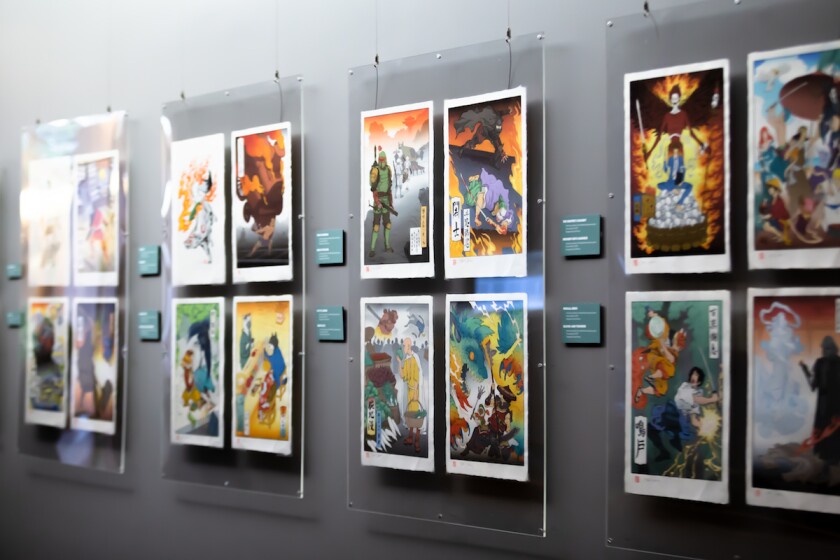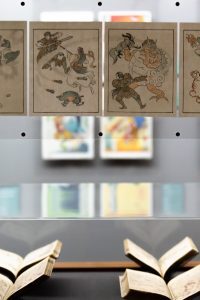
About a decade ago, the ancient form of Japanese woodblock printing was considered by some to be a dying art form — then BYU alumnus Jed Henry came along and shook things up. Henry took a genre of Japanese woodblock printing known as ukiyo-e — which translates into English as 'pictures of the floating world” — and gave it new life by using it to represent his other love: video games. Although Japanese woodblock printing may seem niche, Henry says it is gaining traction. “It’s a growing scene largely because of our efforts to draw attention to this craft, to this medium, through pop culture connections,” he said. Henry’s latest accomplishment is an exhibit in the Harold B. Library Auditorium titled “New Kids on the Block,” which he says is a punny nod to the process of block printing as well as a comment on how he and his business partner, Dave Bull, have “stormed onto the Japanese tradition print making scene.” The exhibit will be up until May 24, 2019. The idea to hold an exhibit at BYU was facilitated by Japanese professor Jack Stoneman, who, according to Henry, thought an exhibit would be a great way to promote Japanese culture on campus. “I’m very grateful for all the hard work and planning that went into making the exhibit look good. I think it was a success,” said Henry. For Henry, the exhibit also represented the first time all of his work has been displayed together. Usually his prints are stored in stacks or in folders in his office and other places. “To have them all up in one place for viewing is a little overwhelming,” said Henry, “I’ve been doing this for seven years now and it’s amazing how much a catalog of pieces can build up over that much time of dedicated, focused work.”

The theme of the exhibit is inspired by Henry’s general approach to his work. “I didn’t do any work to match the theme of the exhibit, but rather the exhibit was created to reflect the focus of my work — breathing new life into a traditional medium by combining it with more relevant pop culture references that speak to modern people,” said Henry. As people look through his work, Henry says the experience is like “a guessing game.” “With the pop culture references we use, I think people have a lot of fun trying to recognize this or that video game or this or that movie when it’s veiled in a new light with this traditional Japanese art style,” said Henry. Henry also hopes that individuals who view the exhibit will be inspired to learn more about traditional Japanese printmaking and perhaps even experiment with it on their own. Through his and his business partner’s efforts, many people have been introduced to the art form. Henry says he works with individuals from all over the world, including Brazil, Mexico and the U.K. His work has also paved the way for more diversity in the industry. “A lot of our partners, employees and contractors are women who — as it is with most things in Japanese traditional culture — were traditionally excluded from participation,” said Henry. “They are very talented craftspeople who otherwise might not have been able to have work in the male-dominated arena of Japanese printmaking.” Henry and his partner have created hundreds of jobs in the craft, something Henry says is funny since they’re “an American guy and a Canadian guy.” But Henry’s widespread success may never have happened were it not for his outlook on art.

“I always approach my work as a balance between what I want to express as an artist and also what I think customers will want,” said Henry. “Be yourself as an artist and express your true feelings about things through your art — don't be a hack, don't be fake, don't just chase the dollar — but also be your most marketable self.” Approaching art in this manner has allowed Henry to work on art every day and also have a stable economic situation. However, Henry warns that the life of an artist, while enjoyable, is not an easy path. “You have to work harder than most people in life,” said Henry. “The 40-hour work week with three weeks of paid vacation and benefits may not be the life that you get to live, but you can be very successful in the arts if you are willing to approach your work from a 50-50 balance between artistic integrity or emotional expression balanced with creating products that people want to buy, collect or display in their homes.” Henry says this attitude was something he picked up during his time as an undergraduate in BYU’s animation program. He said his animation professors, Kelly Loosli and Brent Adams, didn’t shy away from being realistic with him about what it would take to make it as an artist. “Kelly and Brent really galvanized my work ethic, which has continued to this day,” said Henry. “I work crazy hours and I get up really early in the morning so I can get some work done before my kids get up. I try to have a work-life balance, but I sacrifice sleep and maybe some hobbies. I sacrifice those hours to work on this more because I know what it takes to make a living in the arts.” To learn more about Henry and his work, visit his exhibit or watch his documentary “Art of the Game: Ukiyo-e Heroes.”